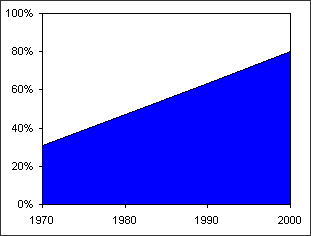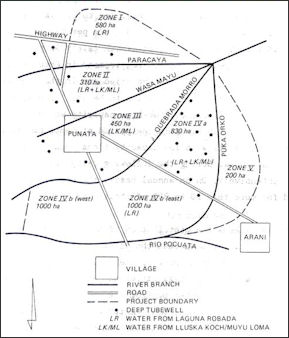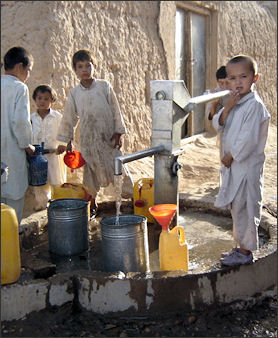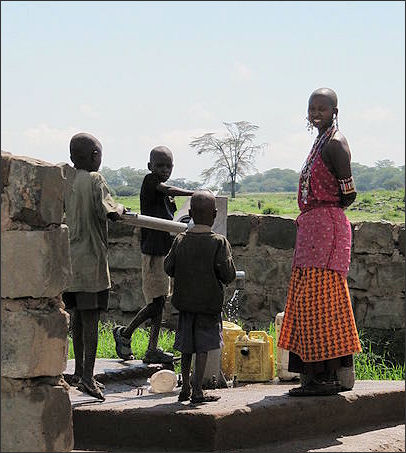WATER IN THE DESERT

Life in the desert is a "constant battle to covert water into survival." Water has traditionally been a source of wealth in desert countries. The powerful controlled wells and irrigation water the way the powerful in agricultural countries controlled land.
Rain does fall occasionally in deserts, and desert storms are often violent. A record 44 millimeters of rain once fell within 3 hours in the Sahara. Large Saharan storms may deliver up to 1 millimeter per minute. Normally dry stream channels, called arroyos or wadis, can quickly fill after heavy rains, and flash floods make these channels dangerous. More people drown in deserts than die of thirst.
Though little rain falls in deserts, deserts receive runoff from ephemeral, or short-lived, streams fed by rain and snow from adjacent highlands. These streams fill the channel with a slurry of mud and commonly transport considerable quantities of sediment for a day or two. Although most deserts are in basins with closed, or interior drainage, a few deserts are crossed by 'exotic' rivers that derive their water from outside the desert. Such rivers infiltrate soils and evaporate large amounts of water on their journeys through the deserts, but their volumes are such that they maintain their continuity. The Nile, the Colorado, and the Yellow are exotic rivers that flow through deserts to dellver thelr sediments to the sea.
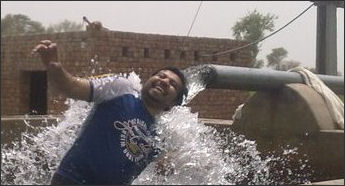
Lakes form where rainfall or meltwater in interior drainage basins is sufficient. Desert lakes are generally shallow, temporary, and salty. Because these lakes are shallow and have a low bottom gradient, wind stress may cause the lake waters to move over many square kilometers. When small lakes dry up, they leave a salt crust or hardpan. The flat area of clay, silt, or sand encrusted with salt that forms is known as a playa. There are more than a hundred playas in North American deserts. Most are relics of large lakes that existed during the last Ice Age about 12,000 years ago. Lake Bonneville was a 52,000-square-kilometer lake almost 300 meters deep in Utah, Nevada, and Idaho during the Ice Age. Today the remnants of Lake Bonneville include Utah's Great Salt Lake, Utah Lake, and Sevier Lake. Because playas are arid land forms from a wetter past, they contain useful clues to climatic change.
Websites and Resources: United States Geological Survey usgs.gov/gip/deserts ; Desert USA (good info on the world’s deserts); desertusa.com/life ; United Nations Global Desert Outlook unep.org/geo/gdoutlook ; Desert Biome article, University of California, Berkeley Desert Biome ; Blue Planet Biomes (about U.S. deserts) blueplanetbiomes.org ; Wikipedia article Wikipedia ;National Geographic online article National Geographic Oxfam Cool Planet oxfam.org.uk/coolplanet ; Sand Dunes article waynesword.palomar.edu ; United States Geological Survey usgs.gov/gip/deserts
Oases

vineyard in Turpan, a large oasis town in Western China Oases are vegetated areas moistened by springs, wells, or by irrigation. Many are artificial. Oases are often the only places in deserts that support crops and permanent habitation. The word “oasis” is believed to have been derived from the Egyptian word wah, which means “fertile place in the desert.”
Oases are usually places in the desert where underground water comes to surface as the result of natural springs or man-made wells. They are usually found in the low or central region of a vast depression or in fissures in a plateau, usually ringed by steep sandstone escarpments.
Oases were described by Herodotus as "islands of the blest." They are often not what people expect them to be. Many times they are quite big. A single oasis can be dozens of miles long and include many villages.
A typical oasis is a basin with fertile soils in their center deposited from wadis. Groundwater is relatively close to the surface. Wells are easy to dig. Agriculture becomes possible and settlements spring up around wells." See Palm Trees Under Dates. Desert Agriculture
Water Sources in the Desert
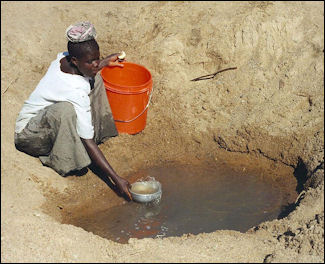
Water comes from springs, wells and seasonal streams. Springs and wells are fed by occasional rains and subterranean penetration of run off water from foothills and mountain ranges. Capillary action brings up ground water from the water table. The water found in wells is often brackish. Often it is okay for camels but unfit for humans.
In some places, particularly in and around oases, water is close enough to the surface that it can be brought up by relatively shallow wells. In most of the desert there is groundwater but is so far below the surface it can only be extracted at great expense, using drills to dig deep wells and pumps to bring it up.
Some places that receive little or no rain receive water from rivers. The most populous desert areas are places where water is brought in by a river that originates outside the desert. That is the case with the Nile in Egypt and the Sudan, the Tigris and Euphrates in Iraq and Syria, and the Indus in Pakistan.
Wadis are seasonal rivers that are dry most of the year and fill up with water during the rainy season. Water can usually be extracted in wadis and at the tip of alluvial fans when no water in present at the surface. The presence of plant life often is indication that water is close enough to the surface that a well can be easily dug.
Aquifers
Aquifers are underground layers of porous rock that contain water. Shallow aquifers can be replenished by rain. Deep aquifers can not be quickly replenished. By some estimates there is a 100 times more underground water than there is surface water in lakes and rivers — enough to support billions of people for centuries.
Much of the world’s water it is at depths of one kilometer or more — too deep to be extracted economically. Drawing too much from shallow aquifers caused environmental damage. Once the water is gone it takes a long time for it be replenished.
In the past drilling deep for water was not seriously considered because it was prohibitively expensive. But these days with water shortages and the rising value of water, drilling for water is being considered more seriously. In some places, geologists armed with same technology used in the oil industry — core drillers and seismographs — are exploring for water and massive underground mapping projects are being carried out to determines the size and amount of water deposits.
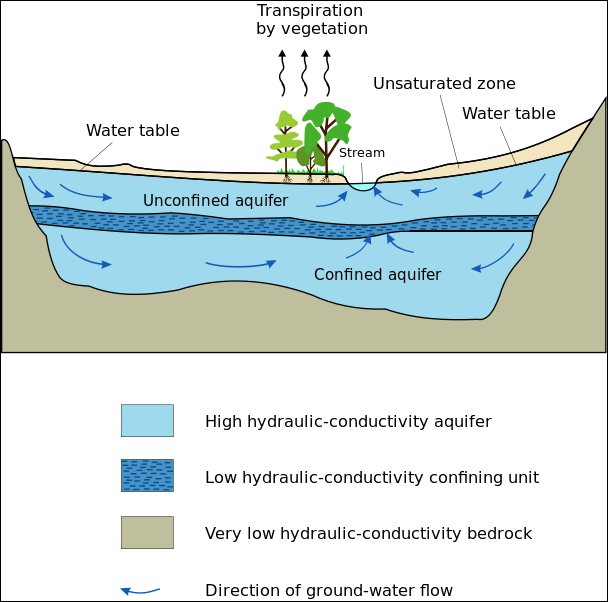
Fossil Water
"Fossil" water is water that has been trapped underground in aquifers for thousands or even millions of years and often dates back to a period when there was more rainfall, rivers and freshwater lakes.
Extracting fossil water is like pumping oil. New drilling technology allows wells over three quarters of mile deep be dug. Water from this wells is so deep it comes to surface piping hot. Sometimes taking out too much water can cause damage. The water is pressured. Once it is removed its may cause the ground above it to subside and upset the geology in other ways. Like oil once fossil water is gone it is gone for good. .
Deep artesian wells can be dug where a rock structure hold water under pressure. In some oases an artesian spring flows to the surface through a crack in the rock.
Water
Only about 1 percent of the world’s fresh water is available for consumption by the world’s 6.6 billion people. Water makes up as much as 70 percent of our bodies and is necessary our most fundamental biological and chemical reactions. Every cell in the body needs water. People can rarely can for go for more than a week without water. The body needs to replace the liter or more it loses every day.
Access to drinking water in Third World Water is often treated like it is common property — free to use no matter what you do with it or how much you use. As a result huge amounts of it are wasted.
Global water consumption grew sevenfold in the 20th century. As it stands now every one percent of population rise is accompanied by a two to three percent rise in water consumption.
A poem by the late economist Kenneth Boulding goes:
Water is politics, water’s religion
Water is about everyone’s pigeon...
Water is tragical, water is comical.
Water is far from pure economical.
Uses of Water
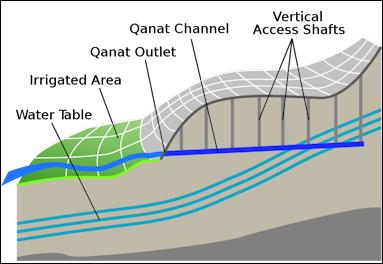
Qanat underground irrigation People use water for drinking and hygiene. Around 20 to 50 liters a day per person is regarded as a minimum for basic needs such as drinking, cooking, bathing and sanitation (Americans consume between 400 and 600 liters a day). Far more is used by industry and in agriculture and food production.
About 70 percent of the water used worldwide is used for agriculture. In some developing countries the figure reaches 90 percent. It takes about 1400 liters of water to produce a kilogram of wheat; 2800 liters of water to produce a kilogram of rice; 14,000 liters of water to produce a kilogram of beef; and even more than that to produce a cotton T-shirt.. Industry uses another 22 percent. Only about 8 percent goes to personal use.
As development increases and more people eat meat and have access to flush toilets and showers, water consumption also rises. Raising a cow requires a thousand times more water than the equivalent amount of food in the form of grain.
Water Problems
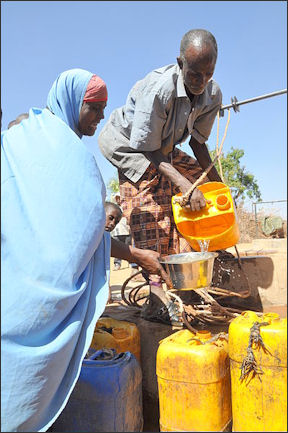
Somaliland Drought
More than 1 billion people worldwide lack access to safe drinking water and 2.6 billion people lack sanitation. More than 80 countries representing 40 percent of the world’s population regularly experience serious water shortages. In sub-Saharan Africa half of most people’s water consumption takes place outside the home. The International Water Management Institute (IWMI) estimates that one third of humans lacks reliable access to safe water either because the water is unsafe, unaffordable or unavailable. By 2025 the United Nations predicts 3 billion people will be seeking clean water.
The average amount of water used by some people per day in countries like Somalia, Mali, Mozambique, Eritrea, Ethiopia, Gambia, Tanzania, Uganda and Djibouti is equal to what people in some developed countries use when they run the tap while brushing their teeth.
In 2007, the United Nations declared water a “global crisis” and more or less said a U.N. Millennium Development Goal of halving the proportion of people without clean water between 2000 and 2015 was heading for failure. The United Nations has realized there was a problem for some time. It declared the 1980s “the decade of water” but made little headway on the problem then.
In many places people have water to drink. What they lack is safe water to drink. Open defecation is a standard practice in many parts of the developing world and run off from this inevitably dirties local water supplies.
Urbanization causes local water shortages as ground water is pumped out and surface water is polluted. The rapid growth of the world’s cities has put stresses on urban water systems and infrastructure that cities can’t afford to fix. Inequality of water access is another problem. In Jakarta, for example, slum dwellers pay five to 10 times more for water than the wealthy.
The world’s water is terribly managed. In the cities much of it is lost to leaky pipes. In the countryside much it vanishes into the air from open irrigation canals. John Briscoe, a water advisor at the World Bank for 10 years, told Vanity Fair magazine, all over the world “you have hugely underfunded, very inefficient services producing very bad service...Subsidies go where the power is.” Governments “don’t have enough money to operate the system properly, so the existing system rations water, and of course it’s the elite that go to the front of the queue.”
Waste is awful. Agriculture accounts for 80 percent of the world’s water consumption but 60 percent of the water used for irrigation is lost to evaporation, leaky canals, or is contaminated by fertilizer and pesticide residues.
Water Disputes
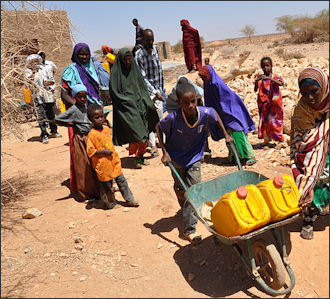
Somaliland Drought Scientists and government officials predict that in the coming decades water, not oil, will become the most important resource and the one that holds the greatest potential for conflict. Disputes between countries over water could escalate into war. There has been some discussion of setting up peacekeeping forces to deal with water disputes.
The United Nations has yet to develop a scheme on how to divide the water of major rivers between countries that share it. This applies to the Nile, the Danube, the Euphrates River and others. The greatest potential for conflict involves countries with mountains that are sources of rivers sometimes build dams that prevent water from reaching neighboring countries, which are not comfortable with the fact that source country has the power to cut off or greatly reduce their water supply.
There are political problems and potentials for war if two countries extract water from the same aquifer. None of the numerous treaties on water use cover underground water. There are also conflicts within countries as to who will get water: primary between cities and farms. Environmental refugees from places with water shortages flock to the rich countries.
Water Shortages
 The World Meteorological Organization regards drinking water shortages as among the primary obstacles to sustainable development. Currently one third of humanity experiences permanent water shortages. Two thirds may experience the problem if population and global warming trends continue.
The World Meteorological Organization regards drinking water shortages as among the primary obstacles to sustainable development. Currently one third of humanity experiences permanent water shortages. Two thirds may experience the problem if population and global warming trends continue.
The shortage of water is a big problem in many cities. Water is sometimes turned on only a couple of times a day for about a half hour each time. People with money have special storage tanks to collect water during those times, which in turn allows them to have water around the clock. People without storage tanks collect water in jugs and buckets and often have to take bucket baths when the water is not turned on.
Beijing suffers from water shortages. It sits on a plain without large rivers and receives little rain fall. The water supplied by reservoirs isn't enough to meet demand and much of that is diverted to irrigate farmland and provide water for factories. As one drives outside of Beijing one crosses a number of bridges of rivers that are blue lines on a map but are empty river beds except after a heavy rain. Water extracted from groundwater supplies has caused the water to table to fall from 16 feet below sea level in 1950 to 164 feet below sea level in 1993. The water that is available is often polluted. Drinking water has traditionally been taken from two reservoirs, but since 1997 it has been taken from one because the water from the other is too polluted to use for drinking.
Water shortages are affecting agricultural areas. Water tables are falling almost everywhere. Repeated drilling and well building has caused the water table to drop in some places by as much as four feet a year and outpaced the amount of water replenished by rain. The North China Plain, which produces half of China’s wheat and corn, is among the places that suffer from this problem. In some places the pumping of ground water has caused the ground to sink and collapse.
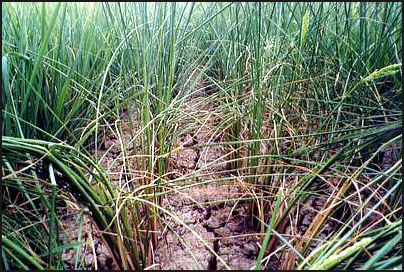
water shortage in China In some places wells have completely dried up and farmers can only grow the most drought-resistant crops. In yet other places, fights have broken out between villages over makeshift dams set up to divert water to fields. Sometimes the disputes have grown into riots that have left people dead and injured. Water supplies are very short in Shanxi Province in northern China. There a typical family uses five buckets of water a day compared to 28 per person in Japan. To save water families use waste water from laundry to flush their toilets and water left over from washing vegetables to water plants.
Causes of water shortages include swelling population, depletion of groundwater, wasteful irrigation, waste, pollution and global warming. In many places agriculture relies too much on ground water for irrigation. In urban areas many people illegally tap into water supplies without paying for it. In places where there is ample water is wasted in leaky pipes and other substandard infrastructure. Fixing leak pipes is an expensive, time-consuming endeavor that can take decades to complete.
Reports: “The U.N. World Water Development Report 2009" by UNESCO; “India’s Water Economy: Bracing for a Turbulent Future” and “Pakistan’s Water Economy: Running Worry” by the World Bank; and “Asia’s Next Challenge: Securing the Region’s Water Future”.
Consequence of Water Shortages
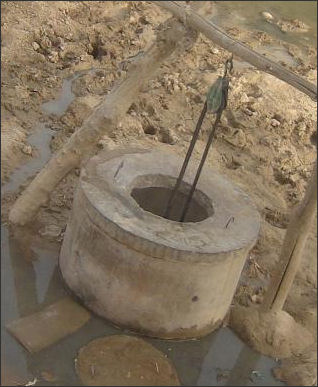
well dug in Afghanistan The consequence of water shortages include drought and famine, loss of livelihoods, the spread of water-borne disease, forced migrations and even conflicts.
Poverty expert Jeffrey Sachs of the Earth Institute of Columbia University wrote: “Many conflicts are caused or inflamed by water scarcity. The conflicts from Chad to Darfur, Sudan to the Ogaden desert of Ethiopia to Somalia and it pirates and across to Yemen, Iraq, Pakistan and Afghanistan, lie in a great arc of arid lands, where water scarcity is leading to failed crops, dying livestock extreme poverty, and desperation.”
“Extremist groups like the Taliban find ample recruitment possibilities in such impoverished communities. Governments lose their legitimacy, when they cannot guarantee their populations’ most basic needs: safe drinking water, staple food crops, and fodder and water for animal herds on which communities depend for their meager livelihoods....Politicians, diplomats and generals in conflict-ridden countries typically treat these crises as they would any other political or military challenge. They mobilize armies, organize political factions, combat warlords.”
“ The United States and Europe often spend ten or even hundreds of billions of dollars to send troops or bombers to quell uprisings or target “failed states,” but do not send one-tenth to one-hundredths that amount to address the underlying crises of water scarcity and underdevelopment.
Solutions to Water Shortages
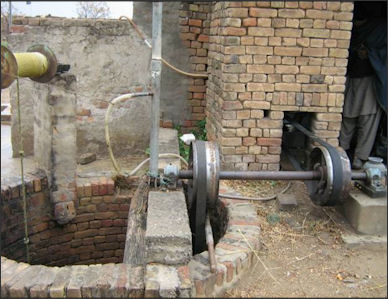
tube well Among the solutions to water scarcity are better water management, improved technologies to increase efficiency, higher prices for water to decease waste, conservation, investments by governments, the private sector and communities in basic water infrastructure, and cooperation among communities sharing water sources.
Sachs wrote: “Most governments are poorly equipped to deal with serious water challenges. Water ministries are typically staffed with engineers and generalist civil servants yet lasting solutions to water challenges require a broad range of expert knowledge about climate, ecology, farming, population, engineering , economics, community, politics, and local cultures. Government officials also need the skill and flexibility to work with local governments, private businesses, international organizations, and potential donors.
The World Bank, International Monetary Fund, Asian Development Bank are all involved in funding water projects around the globe. Private companies are also involved. In Senegal, the world’s leading pipe maker JM Eagle donated 100 kilometers of piping that is used to bring water to tens of thousands of people.
Water Pricing and Waste-Water Recycling
tube well plan Pricing water to make it more dear is increasingly being seen as the primary solution to the world’s water problems. When water prices were significantly raised in the United States in the 1960s and the money was used to improve irrigation, push low-capacity toilets and build water treatment facilities and the like, per capita water consumption fell by more than a quarter. In the developing world, however, it is hard to take similar measures because people are simply too poor to absorb any increase in water prices.
In the developed world where water shortages are acute, governments are increasingly looking into waste-water-recycling plants that can recycle sewage into a drinking water. One such plant in Orange County, California cost $480 million to build and requires $29 million annually to run. At this facility dark brown sludge that enters the system first goes through vertical tubes filled with polypropylene tubes that thickness of dental floss that are filled with holes 1/300th the size of a human hair that filters out many bacteria and protozoa as well as nasty “suspended solids.” Every 20 minutes are so there is a backwash or water and air blasts the tubes clean.
After that the water is pumped into the reverse osmosis chambers where it is mixed with sulfuric acid to lower the pH and pushed though several sheets of plastic membranes that removes salts, viruses and pharmaceuticals. After this hydrogen peroxide, a disinfectant, is added to the water which is then zapped with ultraviolet light, and decarbonized. For a final step lime is added to raise the pH. The result: clean water.
Water Conservation and Tube Wells
tube well in Afghanistan Some old tried and true methods are being brought back such as harvesting, transporting and storing rain water. In some cases these technologies are being revived because modern technology has not supplied all the answers. System that use catchments, gutters and other channels, storage tanks and gravity or pump driven delivery systems, for example, are cheaper or at least equal in cost to drilling and building a well.
Raised ridges up to 10 meters wide are alternated with shallow canals to channel water, either harvested rain or deviated river water. This not only helps to water crops but also stores heat and keeps the fields warm on cold nights.
A tube well is type of well comprised of a relatively narrow cylinders sunk into the ground and a hand pump above ground. It taps into clean groundwater or natural aquifers. Tube wells can be dug very deep using technology similar to that used in the oil industry.
There is a concern that uncontrolled tube well use might lead to a water crisis. In some places farmers using tube wells with electric pumps are sucking up groundwater reserves much faster than can be replenished. Tens of thousands of these wells have been dug, often beyond official control. The problem is particularly acute in places where there is relatively little water and a particularly high number of people. In some cases the water is wasted nourishing water-thirsty crops like alfalfa, rice and sugar cane.
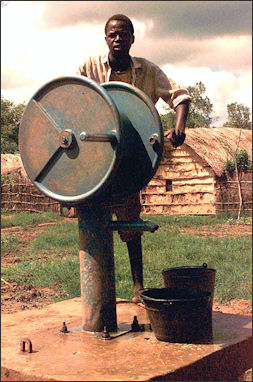
Manual pump in Somalia
Water-Extracting Methods and Low-Tech Water Technology
Low-tech technologies used to collect water in arid regions include: 1) fine mesh “fog catching” nets stretched between poles that collect usable water from fog; 2) “rooftop harvesting” using pipes that divert rain from rooftops into a cistern; and 3) desalination cones placed in saltwater. With the latter sun evaporates water, which condenses on the cones inner wall and trickles down into collection areas around the bottom edges.
Water can be conserved by repairing leaky pipes, lining irrigation ditches to prevent leakage, covering irrigation ditches to prevent evaporation, using water-saving technology, and reducing water intensive crops like rice, cotton and sugar cane. Scientists have experimented with collecting dew with miles of nylon filament.
Among the low-tech water technology used to provide water and make it safe are: 1) filtration straws that trap disease-causing bacteria allowing people to safely drink untreated water (already over two million especially use such straws, which cost about $3 each, See LifeStraw,); 2) folding fine-weave clothing like an old sari four times to filter out pathogens like the cholera-causing bacteria; and 3) bamboo treadle pumps made up of inexpensive local materials that help farmers tap ground water to irrigate small plots of land.
Privatizing Water
Masai pumping water Prices for water are artificially low in many desert countries, which encourages waste. The easiest solution here is to raise the price of water.
Many feel the solution to the world’s water problems is privatizing it. Siemens, GE and Dow are among the companies that have realized there is money to be made in water. Much of their focus has been on water treatment and gobbling up companies in this sector in preparation for long term strategies. Many are looking to the Middle East, which awash in oil money but is lacking in fresh water, and China which also suffers from water shortages and is becoming wealthy enough to pay for big projects.
But there is a lot of resistance from users and potential suppliers. In some circles there are even calls to make water a human right. Business also has its doubts. Companies say water requires a high initial investment but “the payback period is long, rate of return low and the risks are high.” Companies want assurances from partner governments and possibly the World Bank that will get a reasonable rate of return to justify long term commitments. One of their primary reservations is that will invest large amounts hard currency and be paid in worthless, local currency.
As it stands the private sector supplies water for only 5 percent of the world’s population. In the mid 1980s, the World Bank pressured governments in Asia and Latin America to privatize and deregulate water and utility services and open them up to the private sector. The results were disastrous. Companies demanded price increases to pay for modernization and expansion. Governments initially went along but public protests causes them to change their. Many projects were killed after the companies had already made sizable investments nets many of the projects and foreign companies got burned as government broke their promises with them.
Mineral Resources in Deserts
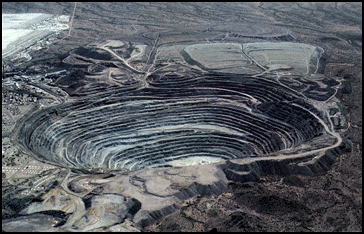
copper mine in Arizona Some mineral deposits are formed, improved, or preserved by geologic processes that occur in arid lands as a consequence of climate. Ground water leaches ore minerals and redeposits them in zones near the water table. This leaching process concentrates these minerals as ore that can be mined. Of the 15 major types of mineral deposits in the Western Hemisphere formed by action of ground water, 13 occur in deserts.
Evaporation in arid lands enriches mineral accumulation in their lakes. Playas may be sources of mineral deposits formed by evaporation. Water evaporating in closed basins precipitates minerals such as gypsum, salts (including sodium nitrate and sodium chloride), and borates. The minerals formed in these evaporite deposits depend on the composition and temperature of the saline waters at the time of deposition.
Significant evaporite resources occur in the Great Basin Desert of the United States, mineral deposits made forever famous by the "20-mule teams" that once hauled borax-laden wagons from Death Valley to the railroad. Boron, from borax and borate evaporites, is an essential ingredient in the manufacture of glass, ceramics, enamel, agricultural chemicals, water softeners, and pharmaceuticals. Borates are mined from evaporite deposits at Searles Lake, California, and other desert locations. The total value of chemicals that have been produced from Searles Lake substantially exceeds $1 billion.
Some deserts are rich in soluble salts. The most valuable is sodium nitrate. The Atacama Desert of South America is unique among the deserts of the world in its great abundance of saline minerals. Sodium nitrate has been mined for explosives and fertilizer in the Atacama since the middle of the 19th century. Nearly 3 million metric tons were mined during World War I.
Valuable minerals located in arid lands include copper in the United States, Chile, Peru, and Iran; iron and lead-zinc ore in Australia; chromite in Turkey; and gold, silver, and uranium deposits in Australia and the United States. Nonmetallic mineral resources and rocks such as beryllium, mica, lithium, clays, pumice, and scoria also occur in arid regions. Sodium carbonate, sulfate, borate, nitrate, lithium, bromine, iodine, calcium, and strontium compounds come from sediments and near-surface brines formed by evaporation of inland bodies of water, often during geologically recent times.
An open-pit mine in the Sonoran Desert near Ajo, Arizona, has exposed an elliptical copper deposit about 1,000 meters long and 750 meters wide. The copper ore mined here is in a bed that averages 150 meters in thickness. The Green River Formation of Colorado, Wyoming, and Utah contains alluvial fan deposits and playa evaporites created in a huge lake whose level fluctuated for millions of years. Economically significant deposits of trona, a major source of sodium compounds, and thick layers of oil shale were created in the arid environment.
Some of the more productive petroleum areas on Earth are found in arid and semiarid regions of Africa and the Mideast, although the oil reservoirs were originally formed in shallow marine environments. Recent climate change has placed these reservoirs in an arid environment. Other oil reservoirs, however, are presumed to be eolian in origin and are presently found in humid environments. The Rotliegendes, a hydrocarbon reservoir in the North Sea, is associated with extensive evaporite deposits. Many of the major U.S. hydrocarbon resources may come from eolian sands. Ancient alluvial fan sequences may also be hydrocarbon reservoirs.
Minerals and oil are expensive to transport.
Image Sources: Wikimedia Commons; USGS ; Xinhua
Text Sources: "Deserts Geology and Resources" by A.S. Walkers, USGS Online publication; Rick Gore, National Geographic, November 1979 [┵]; New York Times, Washington Post, Los Angeles Times, Daily Yomiuri, Times of London, National Geographic, The New Yorker, Time, Newsweek, Reuters, AP, Lonely Planet Guides, Compton’s Encyclopedia and various books and other publications.
Last updated March 2011

